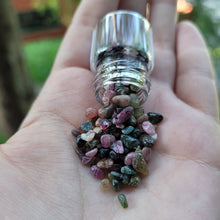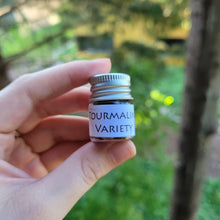Specifications:
*All stone chips are sold by weight. You may choose to have your stone chips packaged individually in glass jars (as seen in photo) or in a bulk bag (plastic or paper depending on availability) if you choose qty (2+) of any stone chip!*
General Information:
Tourmaline displays a greater range of colors than almost any other known gemstone. The most common color available is black, but every color of the rainbow can be found. There is a tourmaline color that can mimic almost any other gemstone. This is why it is one of the most interesting gems to gemologists and jewelry designers. At one time, red tourmalines were thought to be other gemstones! Many stones in the Russian Crown jewels from the 17th century--once thought to be rubies--are actually tourmalines.
Tourmaline is renowned as the gem of sensitive poets and creative artists. (Shakespeare even had a small collection of tourmaline jewelry to help him overcome writer's block.) Tourmaline is believed to inspire creativity and was used extensively as a talisman by artists and writers from the Renaissance through the Victorian Age.
The rarest member of the tourmaline family is the pink tourmaline. In fact, it is even rarer than a ruby! The Empress Dowager Tz'u-hsi (tzoo-she), the last Empress of China, adored and avidly collected pink tourmaline. During her lifetime, she bought nearly a ton of it from the Himalaya Mine in California, USA. When she died, she was laid to rest among all her jewels, and her head was set upon a prized pillow of carved pink tourmaline.
When heated or rubbed, tourmaline acquires an electric charge and attracts small objects like dust, ashes and other lightweight objects, much like amber. This phenomenon is called piezoelectricity (pay-zoh-electricity), and it is considered a unique property. The first documented record of piezoelectricity is in the early 18th century.
In addition to its use in jewelry, tourmaline has been employed in pressure devices because of its piezoelectric properties. It has been used in sonar apparatus and other devices that detect and measure variables of pressure, too.
Because of its electric charge capabilities, the demand for tourmaline increased during WWII for the production of pressure sensitive gauges for submarine sonar instrumentation as well as other war equipment that became significant.
Proper Care of Tourmaline:
Do not store tourmaline with harder gemstones or other materials that might rub against it and cause damage. As with all gems, protect tourmaline from scratches and sharp blows that could shatter it. Also, avoid large temperature changes that can cause the crystal to fracture (such as leaving it near a heater vent or in a hot car).
Do not clean tourmaline in a home ultrasonic cleaner! Tourmaline jewelry can be cleaned with a mild solution of gentle dishwashing detergent and water at home. Soak the stone for 10-20 minutes, then wipe gently but firmly with a wash towel.
*For educational purposes only. This information has not been evaluated by the Food and Drug Administration.
This information is not intended to diagnose, treat, cure, or prevent any disease.*
- Natural
- Mini size chips
- Undrilled
- Mohs Hardness 7-7.5
- Sold per 10 gram package
*All stone chips are sold by weight. You may choose to have your stone chips packaged individually in glass jars (as seen in photo) or in a bulk bag (plastic or paper depending on availability) if you choose qty (2+) of any stone chip!*
General Information:
Tourmaline displays a greater range of colors than almost any other known gemstone. The most common color available is black, but every color of the rainbow can be found. There is a tourmaline color that can mimic almost any other gemstone. This is why it is one of the most interesting gems to gemologists and jewelry designers. At one time, red tourmalines were thought to be other gemstones! Many stones in the Russian Crown jewels from the 17th century--once thought to be rubies--are actually tourmalines.
Tourmaline is renowned as the gem of sensitive poets and creative artists. (Shakespeare even had a small collection of tourmaline jewelry to help him overcome writer's block.) Tourmaline is believed to inspire creativity and was used extensively as a talisman by artists and writers from the Renaissance through the Victorian Age.
The rarest member of the tourmaline family is the pink tourmaline. In fact, it is even rarer than a ruby! The Empress Dowager Tz'u-hsi (tzoo-she), the last Empress of China, adored and avidly collected pink tourmaline. During her lifetime, she bought nearly a ton of it from the Himalaya Mine in California, USA. When she died, she was laid to rest among all her jewels, and her head was set upon a prized pillow of carved pink tourmaline.
When heated or rubbed, tourmaline acquires an electric charge and attracts small objects like dust, ashes and other lightweight objects, much like amber. This phenomenon is called piezoelectricity (pay-zoh-electricity), and it is considered a unique property. The first documented record of piezoelectricity is in the early 18th century.
In addition to its use in jewelry, tourmaline has been employed in pressure devices because of its piezoelectric properties. It has been used in sonar apparatus and other devices that detect and measure variables of pressure, too.
Because of its electric charge capabilities, the demand for tourmaline increased during WWII for the production of pressure sensitive gauges for submarine sonar instrumentation as well as other war equipment that became significant.
Proper Care of Tourmaline:
Do not store tourmaline with harder gemstones or other materials that might rub against it and cause damage. As with all gems, protect tourmaline from scratches and sharp blows that could shatter it. Also, avoid large temperature changes that can cause the crystal to fracture (such as leaving it near a heater vent or in a hot car).
Do not clean tourmaline in a home ultrasonic cleaner! Tourmaline jewelry can be cleaned with a mild solution of gentle dishwashing detergent and water at home. Soak the stone for 10-20 minutes, then wipe gently but firmly with a wash towel.
*For educational purposes only. This information has not been evaluated by the Food and Drug Administration.
This information is not intended to diagnose, treat, cure, or prevent any disease.*




